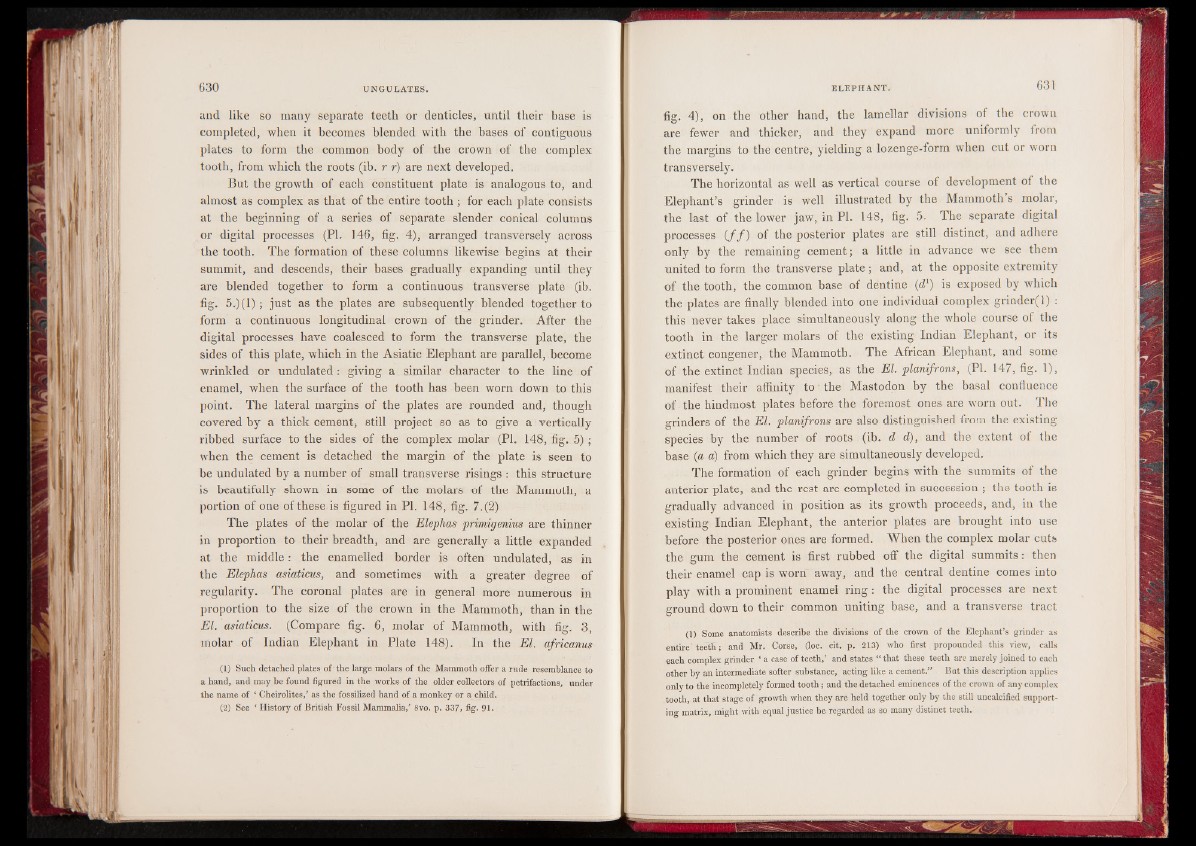
and like so many separate teeth or denticles, until their base is
completed, when it becomes blended with the bases of contiguous
plates to form the common body of the crown of the complex
tooth, from which the roots (ib. r r) are next developed.
But the growth of each constituent plate is analogous to, and
almost as complex as that of the entire tooth ; for each plate consists
at the beginning of a series of separate slender conical columns
or digital processes (PL 146, fig. 4), arranged transversely across
the tooth. The formation of these columns likewise begins at their
summit, and descends, their bases gradually expanding until they
are blended together to form a continuous transverse plate (ib.
fig. 5.)(1); just as the plates are subsequently blended together to
form a continuous longitudinal crown of the grinder. After the
digital processes have coalesced to form the transverse plate, the
sides of this plate, which in the Asiatic Elephant are parallel, become
wrinkled or undulated : giving a similar character to the line of
enamel, when the surface of the tooth has been worn down to this
point. The lateral margins of the plates are rounded and, though
covered by a thick cement, still project so as to give a vertically
ribbed surface to the sides of the complex molar (PI. 148, fig. 5) ;
when the cement is detached the margin, of the plate is seen to
be undulated by a number of small transverse risings : this structure
is beautifully shown in some of the molars of the Mammoth, a
portion of one of these is figured in PL 148, fig. 7.(2)
The plates of the molar of the Elephas primigenius are thinner
in proportion to their breadth, and are generally a little expanded
at the middle: the enamelled border is often undulated, as in
the Elephas asiaticus, and sometimes with a greater degree of
regularity. The coronal plates are in general more numerous in
proportion to the size of the crown in the Mammoth, than in the
El. asiaticus. (Compare fig. 6, molar of Mammoth, with fig. 3 ,
molar of Indian Elephant in Plate 148). In the El. africanus
(1) Such detached plates of the large molars of the Mammoth offer a rude resemblance to
a hand, and may be found figured in the works of the older collectors of petrifactions, under
the name of f Cheirolites/ as the fossilized hand of a monkey or a child.
(2) See * History of British Fossil Mammalia,5 8vo. p. 337, fig. 91.
fig. 4), on the other hand, the lamellar divisions of the crown
are fewer and thicker, and they expand more uniformly from
the margins to the centre, yielding a lozenge-form when cut or worn
transversely.
The horizontal as well as vertical course of development of the
Elephant’s grinder is well illustrated by the Mammoth s molar,
the last of the lower jaw, in Pl. 148, fig. 5. The separate digital
processes (ƒƒ) of the posterior plates are still distinct, and adhere
only by the remaining cement; a little in advance we see them
united to form the transverse plate; and, at the opposite extremity
of the tooth, the common base of dentine (dl) is exposed by which
the plates are finally blended into one individual complex grinder(l) :
this never takes place simultaneously along the whole course of the
tooth in the larger molars of the existing Indian Elephant, or its
extinct congener, the Mammoth. The African Elephant, and some
of the extinct Indian species, as the El. planifrons, (PL 147, fig. 1),
manifest their affinity to the Mastodon by the basal confluence
of the hindmost plates before the foremost ones are worn out. The
grinders of the El. planifrons are also distinguished from the existing
species by the number of roots (ib. d d), and the extent of the
base (a a) from which they are simultaneously developed.
The formation of each grinder begins with the summits of the
anterior plate, and the rest are completed in succession ; the tooth is
gradually advanced in position as its growth proceeds, and, in the
existing Indian Elephant, the anterior plates are brought into use
before the posterior ones are formed. When the complex molar cuts
the gum the cement is first rubbed off the digital summits: then
their enamel cap is worn away, and the central dentine comes into
play with a prominent enamel ring: the digital processes are next
ground down to their common uniting base, and a transverse tract
(1) Some anatomists describe the divisions of the crown of the Elephant’s grinder as
entire'teeth; and Mr. Corse, (loc. cit. p. 213) who first propounded this view, calls
each complex grinder ‘ a case of teeth,’ and states “ that these teeth are merely joined to each
other by an intermediate softer substance, acting like a cement.” But this description applies
only to the incompletely formed tooth; and the detached eminences of the crown of any complex
tooth, at that stage of growth when they are held together only by the still uncalcified supporting
matrix, might with equal justice be regarded as so many distinct teeth.